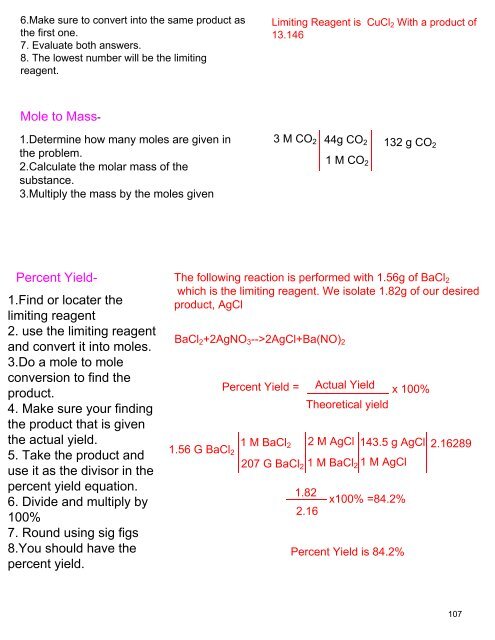Create successful ePaper yourself
Turn your PDF publications into a flip-book with our unique Google optimized e-Paper software.
6.Make sure to convert into the same product as<br />
the first one.<br />
7. Evaluate both answers.<br />
8. The lowest number will be the limiting<br />
reagent.<br />
Limiting Reagent is CuCl 2 With a product of<br />
13.146<br />
Mole to Mass-<br />
1.Determine how many moles are given in<br />
the problem.<br />
2.Calculate the molar mass of the<br />
substance.<br />
3.Multiply the mass by the moles given<br />
3 M CO 2 44g CO 2 132 g CO 2<br />
1 M CO 2<br />
Percent Yield-<br />
1.Find or locater the<br />
limiting reagent<br />
2. use the limiting reagent<br />
and convert it into moles.<br />
3.Do a mole to mole<br />
conversion to find the<br />
product.<br />
4. Make sure your finding<br />
the product that is given<br />
the actual yield.<br />
5. Take the product and<br />
use it as the divisor in the<br />
percent yield equation.<br />
6. Divide and multiply by<br />
100%<br />
7. Round using sig figs<br />
8.You should have the<br />
percent yield.<br />
The following reaction is performed with 1.56g of BaCl 2<br />
which is the limiting reagent. We isolate 1.82g of our desired<br />
product, AgCl<br />
BaCl 2 +2AgNO 3 -->2AgCl+Ba(NO) 2<br />
Percent Yield =<br />
Actual Yield x 100%<br />
Theoretical yield<br />
1 M BaCl<br />
1.56 G BaCl 2 2 M AgCl 143.5 g AgCl 2.16289<br />
2<br />
207 G BaCl 2 1 M BaCl 2 1 M AgCl<br />
1.82<br />
2.16<br />
x100% =84.2%<br />
Percent Yield is 84.2%<br />
107



